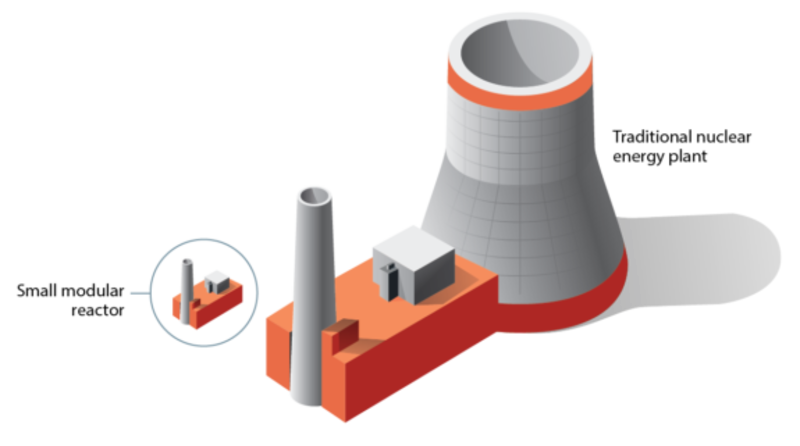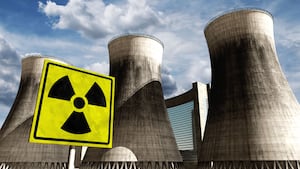Toiling in a Pittsburgh suburb, a Nigerian-born engineer just might hold the key to decarbonization by using an energy source that’s long been maligned and misunderstood: nuclear power.
Dr. Sola Talabi is an adjunct assistant professor of nuclear engineering at the University of Pittsburgh and a senior consultant at Pittsburgh Technical, an advisory firm that provides risk management services to the nuclear energy industry. He’s an expert in advanced small modular reactors (SMR), mini-nuclear plants ranging in size from tens to hundreds of megawatts (MWe).
Like a large reactor, SMRs generate electricity through nuclear fission. In their core, neutrons collide with fuel atoms—usually uranium—splitting them apart. As the atoms split, they release more neutrons, which split more atoms in a sustained chain reaction, and energy. The energy is transferred to a circulating coolant, usually water, causing its temperature to rise. The heated coolant then passes through a heat exchanger, producing steam that drives an electrical turbine and creating usable energy.
Talabi believes that SMRs offer a viable, environmentally-friendly alternative to fossil fuels, able to meet the world’s growing energy demands while slashing carbon emissions and air pollutants. “I think nuclear power has the ability to solve [the world’s two biggest problems:] global energy poverty and global warming,” Talabi told The Daily Beast. “Nuclear can uniquely address those issues.”

A small modular reactor takes up a fraction of the area a traditional nuclear power plant does.
Courtesy of Idaho National LaboratoryWhile novel in the civilian energy sector, SMRs have powered naval warships and submarines for almost 70 years. U.S. naval nuclear reactors have logged more than 5,400 reactor years, and steamed more than 130 million miles without a single radiological incident or radiation-related fatality. This sterling safety record allows the U.S. Navy to operate its reactors largely without controversy even in Japan, a country that has a strong anti-nuclear movement birthed by Hiroshima and Nagasaki, and amplified by Fukushima.
Despite the success, SMRs—and nuclear power as a whole—have failed to catch on in the U.S. civilian energy sector. In fact, nuclear provides only about 20 percent of the nation’s energy, and all from aging large-scale reactors. Incidents such as Three Mile Island, Chernobyl, and Fukushima have further eroded public support. Even if it could overcome the PR hurdles, the industry still faces various financial and supply chain headaches. However, Dr. Talabi insists that all these issues can be solved or minimized by simply scaling down.
For starters, he asserts that SMRs are far safer than large-scale reactors. The worst-case scenarios for traditional nuclear plants are loss of coolant or loss of flow accidents in which a plant loses its ability to remove heat produced by the fuel, and the core melts down. At Three Mile Island, this occurred due to a stuck open relief valve in the plant’s pressurizing system. At Fukushima, it was due to a loss of electrical power to the plant’s reactor coolant pumps.
However, SMRs take advantage of cutting-edge design to eliminate the possibility of such accidents. Circulation through the core is accomplished using thermal convection (hot water rises, cold water sinks), so the plant can remove heat generated by its fuel even if electrical power is lost. Next-generation SMRs are also designed such that they don’t require a pressurizing system like the one that failed at Three Mile Island.
Even in the extraordinarily improbable event of a core meltdown, Talabi said that SMRs are still remarkably safe. Unlike their large-scale predecessors, the diminutive size of SMRs eliminates the need for active safety systems backed by human operators. If radionuclide particles—an unstable element that’s harmful to humans—are released from the core, gravity and other natural phenomena such as thermal and steam concentration will force them to settle safely within the confines of the plant’s containment vessel. In the yet more unlikely case that radionuclide particles breach the containment vessel, Talabi’s research indicates they will settle over a much smaller area than if they were released from a large-scale reactor, posing far less of a health and environmental hazard and simplifying cleanup.
Safety aside, one of the greatest concerns critics have regarding SMRs is their cost. A recent production cost study by the German government holds that over 3,000 SMRs will need to be manufactured to offset their initial construction costs. But Talabi said that estimates like the German government’s are dead wrong. “It’s as though we’ve only ever built tractor-trailers and we’re trying to figure out what the cost of a motorcycle is,” he explained.
Talabi claims that most economists simply take the production cost of a Westinghouse large scale AP1000 reactor—a popular nuclear power plant design—and assume the cost of an SMR will be proportionally smaller. For example, they figure an SMR that produces 100 MWe of power will cost 10 percent as much as an AP1000 that produces 1000 MWe of power. However, the economists don’t realize that many of the systems required by large-scale reactors, such as the ones that maintain pressure and coolant flow in the plant’s core, won’t be miniaturized in the smaller plants. They’ll be eliminated.
SMRs should also be less expensive because they can be factory-fabricated, and their smaller parts will be easier for more manufacturers to produce. While only one or two suppliers worldwide can produce a reactor vessel for an AP1000, many manufacturers in the U.S. alone should be able to make one for an SMR.
Despite his optimism for SMRs’ potential, Talabi acknowledges that they have some drawbacks. Widespread use may slash carbon emissions, but will necessitate increased uranium mining. They also create a security risk, as nuclear fuel will need to be transported between thousands of locations, and reactor sites may be targeted by warring states and terrorists. Government statutes also fail to account for differences between SMRs and large-scale reactors, inhibiting their construction. Developing countries badly in need of electrical power lack the regulatory infrastructure to accept the technology. And their citizens—exposed to nuclear power only through bad news stories—might be even harder to win over than Americans.
That said, Talabi believes that SMRs’ potential in solving climate change and global energy poverty far outweighs their risks, and makes overcoming their obstacles well worth it. To that end, he founded Climate Action Through Nuclear Deployment in Developing Countries (CANDiD). CANDiD hopes to use technology to create regulatory frameworks that developing nations can utilize to accept and operate SMRs. It also aims to better familiarize the global population with the workings and benefits of nuclear plants.
“It’s not a technology challenge,” Talabi said. With public and government support, SMRs could soon be powering the globe with carbon-free electricity. To Talabi, it’s just a matter of awareness and understanding.








